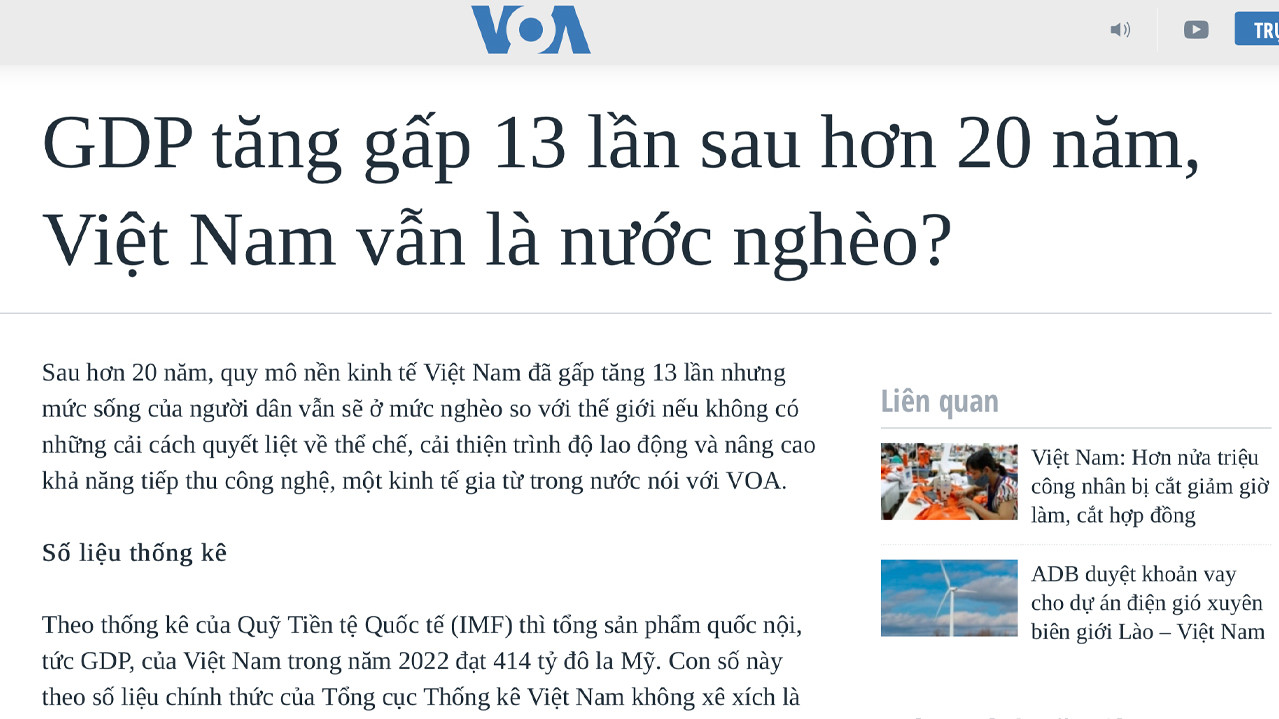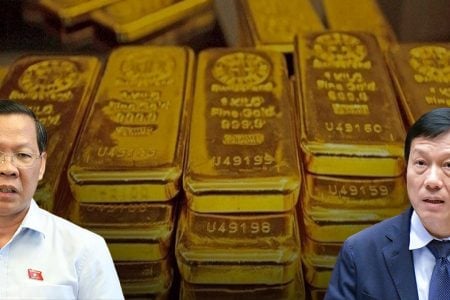
An article on VOA Vietnamese on March 8 commented on unreasonable inadequacies in the Vietnamese economy. Accordingly, the article quoted a domestic expert as saying that, after more than 20 years, the size of Vietnam’s economy has increased by 13 times but people’s living standards will still be poor compared to other countries if. there are no drastic institutional reforms and improvement of labor qualifications and technology absorptive capacity.
However, after 20 years of development, it can be seen that the key issues mentioned by the above expert are difficult to be implemented as long as Vietnam is still under the leadership of the Communist Party.
The article cited statistics showing that Vietnam’s GDP in 2000 was $31 billion and $414 billion in 2022, that is, an increase of 13 times. Currently, Vietnam has come out of the group of poor countries and is classified as a low-middle-income country.
VOA quoted economic expert Pham Chi Lan, who used to be a member of the Prime Minister’s Economic Advisory Group, pointed out the main reasons why Vietnam has made such a remarkable development after more than two decades. These are: institutional reform, foreign investment and participation in free trade agreements.
“Reform changes the economic system to develop according to a market mechanism that creates competition, opens up private businesses, and gives economic rights to all people to do business. On the other hand, it is open to foreign investment to develop trade relations with different countries in the world,” said Ms. Lan.
Another important reason for Vietnam’s economy to rise fast is because Vietnam has joined many free trade agreements (FTAs), including important free trade blocs such as the CPTPP with Japan and other Pacific countries, EVFTA with European countries, RCEP with China and surrounding economies, etc. as well as joining the World Trade Organization (WTO) helps to expand the market for export goods.
In addition, according to Ms. Lan, the sources of foreign investment capital, ie FDI, and development aid, ie ODA, most come from Japan, France and Korea and international organizations such as the World Bank. The World Bank and the Asian Development Bank (ADB) have been „an extremely important resource in terms of capital to help Vietnam develop.“
However, this veteran economist also warned about the inadequacies of the Vietnamese economy, if the government does not fix it, it will be difficult for Vietnam to overcome the middle-income trap and not be able move to become a a high-income country.
Ms. Pham Chi Lan cites the case of „Asian dragons“ such as Korea, Taiwan and Singapore, which have gone from low-income to high-middle income level thanks to „continuously high growth during the period of long time.” Meanwhile, Vietnam’s growth rate has slowed down since the 1990s and 2000s.
Speaking to VOA, Ms. Lan emphasized that besides capital and human resources, Vietnam needs to focus on growth efficiency to ensure sustainable growth in the long run. It is also not a good thing for growth to rely too much on foreign investment, as foreign investors will be the biggest beneficiaries of Vietnam’s growth and domestic people will not benefit much. She pointed to the fact that foreign investment accounts for 72% of Vietnam’s total export turnover, while the contribution of domestic enterprises to exports is „still too modest.“
“In order to increase income for Vietnamese people, it is necessary to strengthen the capacity of Vietnamese entrepreneurs so that the economy has a stronger internal force.”
To develop, the next stage requires both higher technology and higher qualifications of workers. If Vietnam cannot keep up with these two requirements, it will not be able to develop as fast as before and will be stuck in the middle-income trap.
Ms. Lan complained to VOA that the field of education – training „changes quite slowly, so it cannot meet the requirements of the new situation.“
“It is necessary to improve the skills and qualifications of Vietnamese workers and industrial working practices,” she emphasized. „Only then will Vietnam be able to receive the new technology that investors bring in.“
She also suggested that Vietnam innovate institutions and policies to promote technology to help Vietnamese youth develop to their full potential.
“Many young Vietnamese people end up going abroad to do business or develop technologies that they have ideas for, because they are only able to do it outside,” she said.
She also said that green and sustainable growth with a circular economy „is essential for Vietnam to maintain high growth and become more self-reliant.“
“Green growth is an objective requirement of the Vietnamese economy because Vietnam’s largest export markets such as the US, EU, and Japan all have requirements for green standards for products,” said Ms. Lan. know.
Ms. Lan suggested that Vietnam must carry out a second institutional reform to remove bottlenecks that drag the economy back.
“The old state-style thinking that still holds all the fields and interferes a lot in the operation of the market is no longer appropriate.”
Thoibao.de (Translated)


























